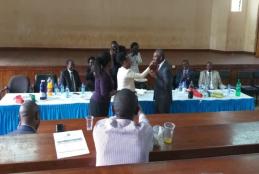CELEBRATION OF CMAAE STUDENTS AFTER GOOD PERFORMANCE IN PRETORIA, SOUTH AFRICA
Prof. John Mburu, Chairman of the Department, was excited because of the good performance of the University of Nairobi. The overall University of Nairobi was number one (1) but last year was number three (3) showing very great improvement. Joyce Waithira Kamau was the second (2) candidate who performed very well and made our Department very proud. First-year students were told to keep up the standard in the coming academic year 2020/2021.

